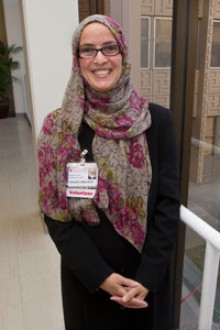Sharing Traditions, Serving the Spirit.
Sharing Traditions, Serving the Spirit
Sherifa Ibrahim has a gentleness about her that is instantly apparent. Her voice is soft, warm in tone and soothing, exactly the balm that might be wanted by someone ill in the hospital. Yet talking is not Ibrahim’s first priority. In her work as a volunteer with Stanford Hospital’s Spiritual Care Service, her primary mission is to be an understanding listener.

Sherifa Ibrahim, a Spiritual Care Service volunteer,
offers insight and compassion to patients and their families.
Nearly 200 volunteers from several countries and different religious faiths bring more than 11,000 hours of their time each year to patients at Stanford Hospital and Lucile Packard Children’s Hospital. Sometimes volunteers assist with familiar rituals, like communion. Or they may become a regular part of the treatment team for patients whose stays extend for many days.
They might be present toward the end of a patient’s life or at a moment when the news is disheartening. Many are retirees, while others find time beyond their regular jobs. Some have been patients at Stanford or are related to former patients. Without exception, they share one thing in common—a generosity of heart, motivated by a desire to help.
Ibrahim comes with a special layer of knowledge. In her native Egypt, she studied to be a pediatrician and graduated from medical school. Her course changed: She married, became the mother of three and moved to the United States. A friend studying at Stanford connected her to the Spiritual Care Service, initially through its associate director, the Rev. John Hester.
“Father Hester has been like a big brother,” she said. “The whole group is wonderful, and the hospital is a friendly and warm environment.”
Ibrahim came to the Spiritual Care Service five years ago, as the group was developing its first training program for Muslim volunteers. Because visiting the sick is one of that faith’s important activities, Ibrahim was especially happy to be of service. And, she said, “I have been a patient, so I know how having someone of the same background, of the same tradition,
can make it easier.”
That means she knows about dietary restrictions and the times during the day when the faithful are called to prayer. She helps Muslims who might not know that when someone is restricted from prayer by illness. “Allah makes it easy. There are some permissions—if you are not able to stand up or sit up or put water on your hands.”
Her knowledge of Arabic has been another blessing. She remembers one Arabic-speaking patient “who had no one else.” She and other volunteers made a point to visit him every day.
She considers her visits to patients as an honor. “You enter the room with a sincere feeling that you are really caring for that patient and can pray with them. You have never seen them before, and you might never see them again, but we are all human.”
On occasion, a patient’s condition might be so critical that “I can’t do anything except to be supportive, to alleviate pain if I can. I try to give hope and strength and positive feelings. I don’t do this for my sake, but for Allah’s sake. I hope that I’m doing something that is pleasing to him.”
By Sara Wykes
Stanford University Medical Center
###
> About Stanford Hospital & Clinics
Stanford Hospital & Clinics is known worldwide for advanced treatment of complex disorders in areas such as cardiovascular care, cancer treatment, neurosciences, surgery, and organ transplants. It is currently ranked No. 17 on the U.S. News & World Report’s “America’s Best Hospitals” list and No. 1 in the San Jose Metropolitan area. Stanford Hospital & Clinics is internationally recognized for translating medical breakthroughs into the care of patients.
###
* Stanford University Medical Center integrates research, medical education and patient care at its three institutions – Stanford University School of Medicine, Stanford Hospital & Clinics and Lucile Packard Children’s Hospital.
** The above story is adapted from materials provided by Stanford University School of Medicine
________________________________________________________________




















